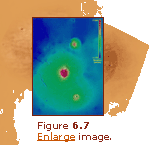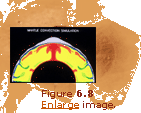|
|

Other Shield Volcanos
|
Another volcanic area is called the Elysium, close to the Viking
II landing site (Figure 6.7) . This area is characterized by three
large volcanos. Both the Tharsis and the Elysium regions are located
on top of a crustal swell. This suggests that they might be a result
of some thermal processes within the Martian interior that caused
surface uplift in these areas and produced magma extrusions.
|
 |
 |
 |
|
 |
Mantle up-welling such as the illustration given in Figure 6.8
can be a plausible mechanism for the origin of these volcanos. Most
of the shield volcanos in Elysium share similar morphological features
with the Olympus Mons, except that they are smaller in size. Generally,
they are relatively young features, as evidenced by the lack of
impact craters. Olympus Mons is estimated to be as young as 200
million years. If it is true, when Olympus Mons last erupted, dinosaurs
were still roaming on the surface of the Earth.
|
< back
1 2 3
4 5
next > |



